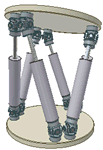



| home |
| about the meeting |
| main speakers and courses |
| talks/posters |
| registration form |
| study group |
| organizers |
| travel & accomodations |
| participants |
| poster |
| timetable |
| contacts |
| documentation |
| impact |

Timetable (Invited talks and Posters)
Invited Talks:- Spectral
methods for
comparing and clustering stationary processes with financial and
economic applications (Nuno
Crato, SPM director, ISEG,Technical
University Lisbon, Portugal)
Abstract: The problem of identifying similarities
or dissimilarities in time series data has been studied for some time
in the discrimination and clustering literature. Many studies
have used metrics based on contemporaneous or quasi-contemporaneous
correlations between different time series. Other studies have used
nonparametric approaches for splitting a set of time series into
different clusters.
We have been working on measures that aim to group time series according to their stochastic properties, independently of their co-movements. We introduced autocorrelation and periodogram measures. Later, we extended the periodogram similarity measures to the case of time series with different lengths. We present some examples showing how these methods can deal with financial and economic time series (This presentation includes some joint work with Jorge Caiado, Instituto Politécnico de Setúbal, and Daniel Peña, Universidad Carlos III de Madrid.)
We have been working on measures that aim to group time series according to their stochastic properties, independently of their co-movements. We introduced autocorrelation and periodogram measures. Later, we extended the periodogram similarity measures to the case of time series with different lengths. We present some examples showing how these methods can deal with financial and economic time series (This presentation includes some joint work with Jorge Caiado, Instituto Politécnico de Setúbal, and Daniel Peña, Universidad Carlos III de Madrid.)
- Monitoring Industrial Processes with Robust Control Statistics (Fernanda Otilia Figueiredo, FEP, CEAUL)
Abstract: The
Shewhart control charts, used for monitoring industrial processes,
are the most popular tools in Statistical Process Control (SPC). They
are usually developed under the assumption of independent and
normally distributed data, an assumption rarely true in practice, and
are usually implemented with estimated control limits. Despite the
advantages of the use of the normal distribution in SPC, it is well
known that most of the datasets from diversified industrial processes
(such as data from telecommunication traffic, insurance, finance and
reliability) exhibit often asymmetry and tails heavier than the
normal tail. As in general we mainly want to control the process mean
value and the process standard deviation, independently of the data
distribution, to monitor these process parameters it seems sensible
to advance with control charts based on robust statistics, because
these statistics are expected to be more resistant to moderate
changes in the underlying process distribution.
In this talk we introduce some background about the total median and the total range statistics, and we present a simulation study on their robustness and efficiency. Then, apart from the traditional control charts, the sample mean and the sample range charts, we consider control charts based on the total median and on the total range statistics for monitoring a cork stopper’s process production. These charts are compared in terms of robustness and performance. (This presentation is a joint work with Maria Ivette Gomes, Universidade de Lisboa, F.C.U.L. (D.E.I.O.) and C.E.A.U.L.).
- Convexity adjustments (Raquel Gaspar, ISEG, Technical University Lisbon, Portugal)
Abstract: This talk is based upon
work with several co-authors, see Gaspar and Murgoci (2008) and
Gaminha, Gaspar and Oliveira (2009). It aims to clarify the notion of
convexity in fixed income markets. The basic and appealing idea behind
the use of convexity adjustments is presented focusing the situations
that are of particular importance to practitioners: yield convexity
adjustments, forward versus futures convexity adjustments, timing and
quanto convexity adjustments (more
info).
- Application
of Fractional
Calculus in Engineering Sciences (J. A. Tenreiro Machado, Institute of
Engineering of Porto, Portugal)
Abstract:
In 1695 L'Hopital wrote a letter to Leibniz asking for the meaning of
Dny for n = 1/2. Leibniz replied 'It seems that useful consequences
shall be drawn from these paradoxes one day, as there are no paradoxes
that do not prove useful'. The term 'Fractional Calculus' (FC) was
adopted at that time and is used even nowadays, although many
researchers find more adequate the terminology 'integration and
differentiation of arbitrary order'. Starting with the ideas of Leibniz
many important mathematicians developed the theoretical concepts, but
practical aspects were not evident. During the thirties A. Gemant and
O. Heaviside applied FC in the areas of mechanical and electrical
engineering, respectively. Nevertheless, these important contributions
were somehow forgotten and only during the eighties, we find relevant
work, by A. Oustaloup, that developed a pioneering work in the FC
application in automatic control systems. In the same period, FC
emerged as an important tool associated with phenomena such as fractal
and chaos and, consequently, in the modeling of dynamical systems. The
ongoing research of FC application addresses many different aspects
such as viscoelasticity and damping, biology, electronics, signal
processing, system identification, diffusion and wave propagation,
percolation, modeling, identification, and control. Bearing these ideas
in mind, this lecture introduces the FC fundamental mathematical
aspects and discuses some of their consequences. Based on the FC
concepts, the lecture reviews the main approaches for implementing
fractional operators. Finally are presented some applications in
engineering, namely the fractional PID controller, heat diffusion
systems, electromagnetism, fractional electrical impedances, and
nonlinear systems.
- Wind Power Forecasting: a motivation to question the ubiquous unquestioned use of Least Squares in training models (Vladimiro Miranda, FEUP/INESC Porto)
Abstract: Supervised training implies the tuning
of parameters in a model so that
its output may match a training set and the model may generalize for
other cases. Least squares or minimum square error (MSE) is a criterion
with generalized use in engineering and in many cases it is applied
without questioning the soundness of this choice - however, this is
only an optimal chioce if the error distribution is Gaussian.
Wins power forecasting is a difficult exercise with important industrial application that has become a good practical example of the advantage of abandoning the MSE paradigm. Departing from the challenge of predicting wind power on a 3-day ahead schedule, one will demonstrate, with practical examples, that criteria associated with the entropy of the error distributionn allow the industry to obtain better predictions and thus save or make money in the power business.
The application to neural networks will be described and other areas of application suggested. Cases tested at INESC Porto will be presented..
Wins power forecasting is a difficult exercise with important industrial application that has become a good practical example of the advantage of abandoning the MSE paradigm. Departing from the challenge of predicting wind power on a 3-day ahead schedule, one will demonstrate, with practical examples, that criteria associated with the entropy of the error distributionn allow the industry to obtain better predictions and thus save or make money in the power business.
The application to neural networks will be described and other areas of application suggested. Cases tested at INESC Porto will be presented..
- Behavioural and dynamical scenarios for contingent claims valuation in incomplete markets (Diogo Pinheiro, U. Minho)
Abstract: We describe three different but related
scenarios for the determination of contingent claims prices in an
incomplete market: one scenario uses a market game approach whereas the
other two are based on risk sharing or regret minimizing
considerations. Furthermore, we point out some dynamical schemes
modelling the convergence of the buyer's and of the seller's prices of
a given asset to a unique price.
- Optimisation methods to improve the use of resources in industry (Jose Soeiro Ferreira, FEUP/INESC Porto)
Abstract: Improving the use of
resources, such as materials, space and time, is a relevant
contribution to increase productivity, to reduce costs and to convey a
better public image. Several industries such as textile, garment,
electronic, leather and shoes, paper, metal, wood and furniture and
glass industry need an everyday plan of patterns or layouts, associated
with the objects or pieces of different shapes to cut or pack, in order
to save expensive materials, to achieve a good usage of space and to
ease the production and cutting tools procedures.The presentation
starts by describing the context of these situations and problems and
will be supported by real applications.Convenient Optimisation models
and Graphs models will be presented and discussed.Resolution approaches
based on Mathematical Programming techniques (Linear and Integer
Optimisation) and Meta-heuristics will also be outlined. Emphasis is
placed on Metaheuristics methods, such as Simulated Annealing, Genetic
Algorithms, Memetic Algorithms and Tabu Search, due to their novelty
and generality.
- Features of Industrial Optimization Problems (Luis Nunes Vicente, Dep. Matematica, FCTUC, Coimbra, Portugal)
Abstract: In this talk we review, in broad and
nontechnical
terms, a number of features and properties of optimization problems
which appear frequently in industrial and computational science
applications.